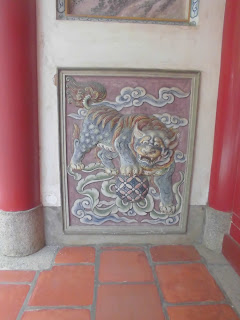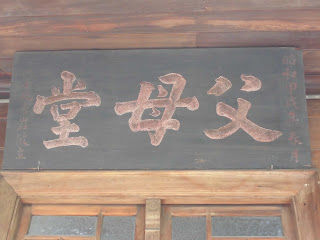雖然我住的地方離開元寺很近,可是我以前都沒有去過。最近我注意到在我附近有這麼厲害的寺廟,就決定去看看。開元寺算是台灣最早建的佛教寺。原本是鄭經蓋的公館,後來變成寺廟。我兩次去。第一次是晚上,所以我不能進去。隔天我又去參觀裡面。
I decided to check out Kaiyuan Monastery recently. It's supposed to be the oldest Buddhist monastery in Taiwan. It was originally built as a home by Koxinga's son. Despite how impressive its history is, and how close it is to where I live, I hadn't ever visited it before. I made two trips, one at night, when it was closed and I could only see the outside gate, and another the next day.
この間開元寺に行ってみた。開元寺は台南のお寺で、台湾内一番古いお寺とされている。元々は鄭成功の息子の邸宅として建てられた。かなり歴史のある場所で家から遠く離れていないのに、行ったことはなかった。二回行って、一回目は夜、そしてその次の日もう一回行った。下の写真は夜の門と私の影だ。
那迦犀那尊者。他是一位十八羅漢。他代表不要聽八卦,只要聽真的話就好了。This is Nagasena, one of the 18 Arhats who are frequently portrayed in Buddhist art in Taiwan. He's cleaning his ear so as to hear better. It's a metaphor for keeping one's ears open to the truth. I love his pained expression.
中国、台湾の仏教美術によく登場する18羅漢の一人、ナーガセーナ。耳掃除しているが、これは正確なことをよく聞く姿勢をとるの大事さを比喩している。すごい顔。
我不確定可是感覺起來佛教寺常常有大象。是因為從印度來的嗎?也感覺起來道教的廟龍比較多。但是兩種都又有龍又有大象。
It seems like Buddhist temples in Taiwan often feature elephants, which don't seem to be featured so often on Taoist temples. I guess maybe this is because of Buddhism's roots in India. (I don't have any solid evidence of that elephants are more common at Buddhist temples; it's just a gut feeling.)
証明できないが、なんとなく台湾の仏教のお寺の方が、道教の廟より像が多い気がする。おそらく仏教のインドつながりが関係しているのだろうか?
Bats around a wheel.
コウモリに囲まれた輪
有可能這位也是羅漢。是阿氏多尊者嗎?
I think this is another Arhat. I've seen similar depictions elsewhere. My totally uneducated guess is that he is either Nakula, Rahula or Asita, but I really have no idea.
この人も羅漢かもしれない。静かに考えている様子だから、ナクラか羅ご羅かアシタと推測する。(アシタは正しい日本語名かどうか分からない。中国語で「阿氏多」と書く。)
這位也是羅漢。他就是布袋!胖胖的總是微笑的布袋在佛神當中應該是看起來最友善的。難怪在他旁邊一直有小朋友!
Another Arhat, Angida. I took that name from the list of Arhats on Wikipedia that I linked above, but I actually know him better as "Hotei" (Japanese) or "Budai" (Chinese). He is always depicted as very fat and bald, and with big earlobes. He also carries a big bag filled with wonders and treasure. He is often depicted with children too.
こちらも羅漢だけど、日本では七福神の一人としての方が馴染みがあるだろう。布袋さんだ。日本と中国の布袋さんのイメージが全く一緒で、体が太って、頭がハゲていて、でかい袋を持っている。子供に囲まれていることも多い。
隔天回來。看到麵。
Like I said above, I came back the next day. There were noodles sitting out here for some reason.
翌日に戻ってきた。なぜか麺がここに置いてある。
在台灣佛教和社會褔祉很有關。這座寺旁邊也有醫院。我喜歡他們好像把醫院的顏色配合寺的。
The temple has a hospital next door. I think this building is part of the hospital complex. I thought it was pretty, and the coloration matches the temple too. Buddhist organizations in Taiwan are well known for their charity and medical activities. In fact, the largest charitable organization in Taiwan, and an organization that has many hospitals as well, is a Buddhist one, Tzu Chi.
台湾の仏教は社会福祉の活動と病院の営業をしている。このお寺の隣にも属している病院があった。色の選択はお寺に合っているから、綺麗だと思った。
進來了。向馬路的門(上面晚上的照片那扇)總是關著,所以從醫院旁邊進來了。
And here are the temple grounds. You actually don't enter through the main gate that I showed above in the nighttime photos. You come in through a side gate.
夜の写真を撮った門は基本的に閉じているので、横の小さな入り口から入ってきた。
On the left here is a big gate just outside the main temple buildings. To the right is an open courtyard which is just inside the main gate I mentioned above that is normally closed. The grounds of this monastery are huge.
左側はお寺の外にある門。右側には広場がある。広場の先は夜の写真に登場した門がある。このお寺は本当に広い。
又有大象。在老虎的對面。應該廟會有龍吧。
Here we have a tiger and an elephant facing each other on either side of the entranceway. In a Taoist temple, it would probably be a tiger and a dragon.
ここにも象さんが登場する。虎の向こうにあるが、道教だったら、多分虎の向こうに龍があるだろう。
很精巧的漢字。
This gate had a lot of fancy script on it.
すごく変わった書き方を使った漢字が門に書かれていた。
竹葉也是漢字!
These bamboo leaves are actually letters! (Chinese, of course.)
この竹の葉っぱも漢字だ!
And here we can see the open courtyard and the closed front gate.
広場と道に面している夜に訪れた門。
The ground has been swept neatly into patterns.
熊手で砂に模様を入れている。
有可能這也是羅漢。慶友尊者?
This guy may be an Arhat too. Perhaps Nantimitolo?
こちらも羅漢かな。龍を抑える一人もいるんだ。
前面的門後。門上的人也有背後。
I thought it was neat that the people in the gate were actually two-sided. Since we're on the inside of the gate, we're seeing their backsides.
門の裏側だから飾っている人達の背中が見える。
The bats from the night photos.
上の写真にも出たコウモリ
賓頭盧尊者?
This may be Pindola since he's wrestling a tiger.
もしかして羅漢の一人。
西遊記的畫
Sun Wukong (Son Goku in Japanese) and company from the famous Chinese novel "Journey to the West".
孫悟空と仲間。
在幹嘛?
Look at this guy!
なんかわけわからんすごいの出てきた。
看起來歐吉桑對茶不滿意。
"What is this? Do you call this tea?"
"S-sorry, sir."
"This is bathwater! That's what it is! Bathwater! Get out of my sight!"
顔が微妙に不満しているから、おそらく相手はまずいお茶を煎れたかもしれない。
脫鞋子走看看就知道了非常痛。
You can take off your shoes and walk on these rocks if you want to improve your circulation, or show how metal you are.
靴を脱いでここを歩いたら多分体か何かにいいだろう。めっちゃ痛いけど。
榕樹的鬍子這樣被繫住。我不知道原因但我猜有可能是因為鬍子到地面就變成株。
The trees in the courtyard are banyan trees. Banyans grow these whiskers from their branches that slowly grow down to the ground. Here, the temple's groundskeeper seems to have collected the whiskers together for some reason. Maybe because they look neater like this? I think they may also turn into a new supporting trunk if they grow into the ground.
広場の木はガジュマル木だ。枝からヒゲみたいなものが垂れ下がってくる。グラウンドの管理人はそれをこういうふうにまとめている。確か、地面に着いたらこれが新しい株になると思う。
這條有可能以前是鬍子。
This may have originally been whiskers if what I said above is right.
これはおそらく株になったヒゲだった。
台南大概的地圖
A very sparse map of Tainan.
めっちゃ使えない台南の地図。
There were lots of squirrels.
松鼠好多
Some collection of old stonework
These banyan whiskers have been tied up into a cute bow!
ガジュマルのヒゲ。可愛くしている。
台灣型的水溜
A water basin in the shape of Taiwan.
台湾型の水溜り。
一直看松鼠
She was fascinated by the squirrels.
この子はずっとリスを見ていた。
我們離院子進去好吧。
Let's finally leave the outer courtyard go through the gate to where the main compound is.
ここから中に入る。
There was this neat wooden building to one side.
入ってから右側に木材建築があった。
現在剛好在重新修建所以我沒辦法參觀中心的建築。好可惜!
Unfortunately, my timing was awful. They're doing a major reconstruction of the main building to protect it from water damage, so I wasn't able to see pretty much any of it. Oops.
残念なことに、ちょうど今はお寺の工事をしている。一番中心で歴史のある建物は結局見れなかった。
Here's the wooden building from before.
我覺得這棟木頭的應該是日本時代建的。
この木材建築は日本っぽいところがあって、日本時代のものかもしれない。
「昭和」って書いている。
I think this may be a Japanese-era building.
照片還是很多。下次繼續。
I took a lot of photos, so I've split this up into two parts. I'll put up the rest in a couple of days.
写真があまりにも多すぎて、今日はここまで。
































































































No comments:
Post a Comment